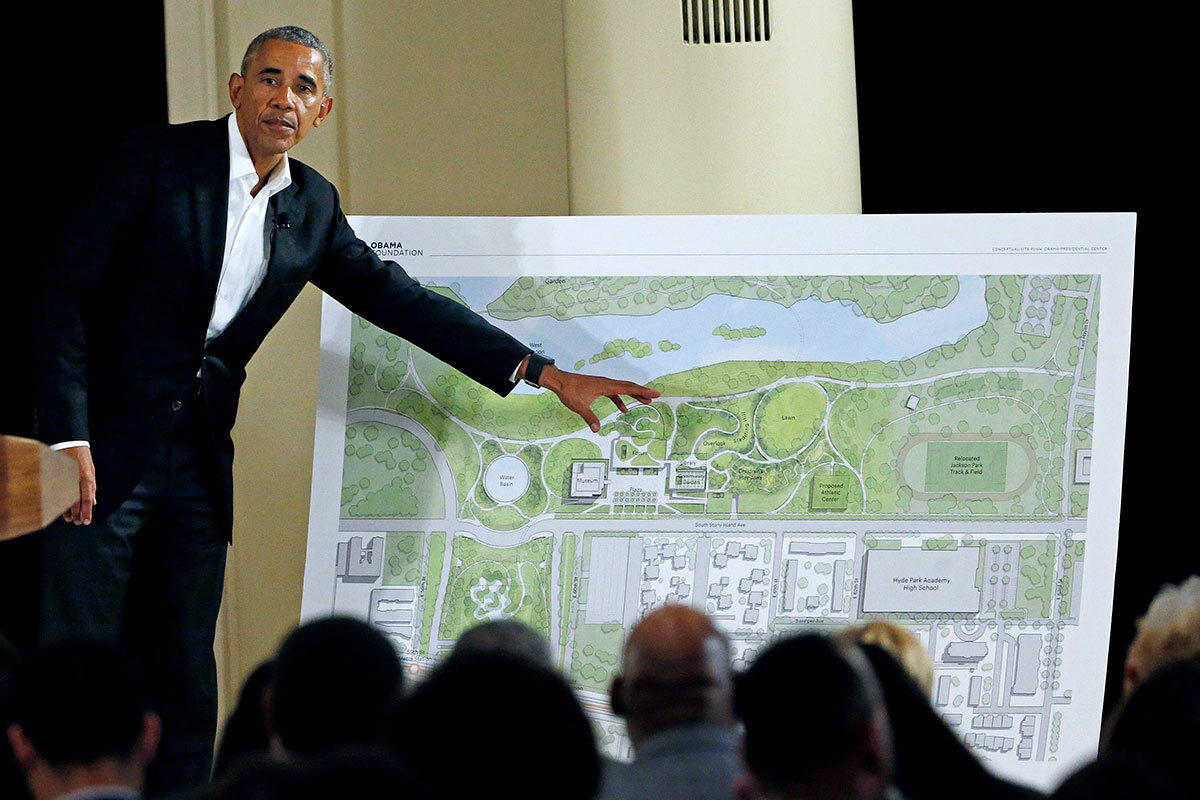Community building: Chicago experiment links libraries and apartments
Loading...
| New York
An experiment in Chicago aims to meet the needs of those in search of housing – and a good book.
The initiative pairs libraries and affordable apartments together in the same buildings. Conceived two years ago, the projects are almost complete, with the three libraries set to open at the end of the year, and the housing units – adjacent or above them – to follow in early 2019.
Buildings and developments that serve more than one purpose, called mixed-use, are trending around the world. From urban spaces where residents can simply go downstairs to reach work or food, to a mosque that serves as a community center, the architecture is focused on bringing people together and promoting effective use of land.
Why We Wrote This
Cities are thinking in new ways about how to use urban space and create opportunities for interaction. In Chicago, a pairing of affordable housing and libraries could affect relations across race and class.
“It’s the innovation of the hybrid building that appealed to me,” says Ralph Johnson, design director at the Chicago office of Perkins+Will, which won the bid for one of the library-housing locations, the Northtown Branch building. “It promotes density. Instead of serving one purpose, it has three times the density of use. The buildings are unique in that sense.”
“Co-location” of public libraries is common in England, and has been used previously in Chicago (with a high school) and also in Los Angeles (with housing).
The idea of trying it with public housing apartments in Chicago came to Mayor Rahm Emanuel during a morning swim in 2016. “People were asking me for more libraries, and I knew we needed to bring affordable housing into good neighborhoods so they’re not so concentrated,” he says in a phone interview. Of combining the two, he adds, “If you can’t solve a problem, make it a bigger problem and see if you can solve it.”
The Chicago Public Library and Chicago Housing Authority soon formed an atypical partnership and identified three library locations: The Roosevelt Branch, in Little Italy on the city’s Near West Side; the Northtown Branch, which was struggling to accommodate its high visitor count, in the West Ridge neighborhood; and the Independence Branch, which had burned down, in the Irving Park neighborhood.
When the mayor’s office announced a competition to design the buildings in late 2016, the city received initial proposals from 32 firms. In addition to Mr. Johnson’s group, John Ronan Architects won the bid for the Independence branch, and Skidmore, Owings & Merrill for the Roosevelt location.
Johnson, who designs all over the world, says he loves working in the city he grew up in. “I like to … do important civic work. I’m helping the image of the city and the social purpose of architecture; it’s the notion of a building as a community.”
Although communities have been involved in discussions about the new buildings, the city received some criticism that citizens should have been included earlier in the design process. And not all residents were immediately welcoming of the idea of public housing in their neighborhoods, citing concerns about safety and destabilization.
“There has been buzz about it, some controversial,” adds Shelley McDowell, a homeschooling mom who frequents the city’s libraries. “With ‘affordable housing’ comes a stigma. Some are concerned that it won’t be good for them or their children.”
But at least one developer argued that without the housing, which helps the whole project qualify for tax credits and federal funding, the city lacks the resources to build the libraries alone. And other community members see the idea's potential for revitalization and connecting people.
“Neighborhoods can be insular here,” says Kendra Mealy Wilk, a children’s librarian at the Roosevelt Branch, which will move to its new location once completed. “So I think this is a wonderful opportunity to bind people together across racial and economic groups.”
Chicago Public Library’s director of government and public affairs, Patrick Molloy, says his office’s goal is to remove barriers for people and provide free resources they can access for the rest of their lives. The three libraries plan to offer updated programming and technology for local patrons.
“Through this process we’ve realized that the Chicago Public Library and Chicago Housing Authority’s missions are not that different,” explains Mr. Molloy. “Our mission is to democratize access.”
Mayor Emanuel says he hopes the idea can serve as a successful model for other cities. He discussed it with Houston Mayor Sylvester Turner when the two met in July.
“Mayor Turner is always curious to see if ‘best practices’ in other cities would work in Houston and this one may be part of that effort eventually,” writes Alan Bernstein, communications director for the Houston mayor’s office, in an email. He notes that Turner called the approach “admirable.”
The Barack Obama Presidential Center will be the next Chicago institution to host a new public library. “Soon we’ll have three affordable housing units, one public high school, and one presidential library that will all have neighborhood libraries,” says Emanuel, a former chief of staff for President Obama.
As for Ms. McDowell, the library patron, she is optimistic about the the potential for the housing pairing. “I hope it will help people who don’t have financial security … better their circumstances,” she says. “And for the people who are more affluent, I hope it educates them about other communities and builds bridges between those different social statuses and communities.”






